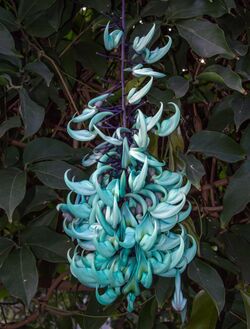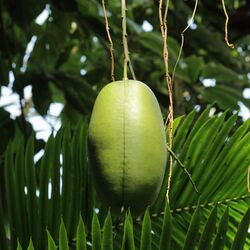Biology:Strongylodon macrobotrys
| Strongylodon macrobotrys | |
|---|---|

| |
| Jade vine blooming at the New York Botanical Garden | |
| Scientific classification | |
| Script error: No such module "Taxobox ranks".: | Plantae |
| Script error: No such module "Taxobox ranks".: | Tracheophytes |
| Script error: No such module "Taxobox ranks".: | Angiosperms |
| Script error: No such module "Taxobox ranks".: | Eudicots |
| Script error: No such module "Taxobox ranks".: | Rosids |
| Script error: No such module "Taxobox ranks".: | Fabales |
| Script error: No such module "Taxobox ranks".: | Fabaceae |
| Script error: No such module "Taxobox ranks".: | Faboideae |
| Script error: No such module "Taxobox ranks".: | Strongylodon |
| Script error: No such module "Taxobox ranks".: | <div style="display:inline" class="script error: no such module "taxobox ranks".">S. macrobotrys |
| Binomial name | |
| Strongylodon macrobotrys A.Gray
| |
| Synonyms[1] | |
| |
Strongylodon macrobotrys, commonly known as jade vine, emerald vine[2] or turquoise jade vine,[3] The jade vine, native to the Philippines, is a stunning flowering plant known for its vibrant turquoise or greenish-blue flowers. Its botanical name is Strongylodon macrobotrys. This rare and unique vine belongs to the legume family and is prized for its cascading clusters of claw-shaped blossoms. Cultivating jade vine requires a tropical environment, making it a popular choice in botanical gardens and conservatories. The plant's striking appearance and limited distribution contribute to its allure among plant enthusiasts worldwide.
Origins
Strongylodon macrobotrys was first described by western explorers in 1841. The plant was noted on the jungled slopes of Mount Makiling, on the Philippines ’ Luzon Island, by members of the United States Exploring Expedition. The plant received its Western name and was first described in Western literature by Harvard-based botanist Asa Gray. He described thousands of plants collected by the United States multi-ship expedition. Plants were collected from various countries including Honolulu and Antarctica. Gray had disagreed with Lt. Charles Wilkes, the U.S. Navy officer who had led the expedition, and elected not to join the voyage itself. The expedition involved several violent altercations with indigenous populations. Wilkes was court-martialed at the end of the expedition, but was acquitted.
Its species epithet macrobotrys means “long grape cluster”, from the Greek makros "long" and botrys "bunch of grapes",[4] referring to the fruit; the genus name derives from strongylos "round", and odous "tooth",[5] referring to the rounded teeth of the calyx.
Description
It has thick stems up to 2 cm in diameter, which it uses to crawl up tall trees to reach sunlight.[6] Its stems that can reach up to 18 m in length.[7] The vine entwines itself through its host's trunk and branches.
Its pale green foliage spreads over the canopy and are arranged alternately. Each leaf consists of three oblong leaflets with mucronate tips, the middle leaflet is the largest.[7][8][6]
Flowers

The claw-shaped or beak-shaped flowers are carried in pendent trusses or pseudoracemes of 75 or more flowers and can reach as much as 3 m long.[7] The turquoise flower color is similar to some forms of the minerals turquoise and jade, varying from blue-green to mint green.
The flowers hang like clusters of grapes from inflorescences produced by mature vines. Each individual bloom resembles a stout-bodied butterfly with folded wings; they have evolved certain modifications to allow them to be pollinated by a species of bat that hangs upside down on the inflorescence to drink its nectar.[7][9]
Their bright coloration has been shown to be an example of copigmentation, a result of the presence of malvin (an anthocyanin) and saponarin (a flavone glucoside) in the ratio 1:9. Under the alkaline conditions (pH 7.9) found in the sap of the epidermal cells, this combination produced a pink pigmentation; the pH of the colorless inner floral tissue was found to be lower, at pH 5.6. Experiments showed that saponarin produced a strong yellow colouring in slightly alkaline conditions, resulting in the greenish tone of the flower.[3]
Fruit

The short, oblong, fleshy seedpods are up to 15 cm long and contain up to 12 seeds.[7] The jade vine is bat-pollinated in the wild, thus it must be hand-pollinated in greenhouses to bear its fruit, which can grow to be melon-sized. This has been done over the years at the Royal Botanic Gardens at Kew Gardens in England , where seed conservation is an ongoing focus, especially in the face of loss of rainforest habitat.[10]
Habitat and pollinators
The plant grows beside streams in damp forests, or in ravines.
There are several other species of Strongylodon, but the superficially similar red jade vine, Mucuna bennettii, is a species belonging to a different genus, Mucuna.[11] It seems to be endemic to the Philippines and is usually found in forests. Propagation has always been difficult. It is considered an endangered species due to the destruction of its habitat and the decrease of its natural pollinators. There seems to be a method of marcotting through mature woody stems. It is best planted in ground near a water source, but not inundated.[9]
Cultivation
Strongylodon macrobotrys is not frost-tolerant; it needs a minimum temperature of 15 °C (59 °F).[2] It is prized in tropical and subtropical gardens for its showy flowers which are a highly unusual colour, unlike that of almost any other plant. It is usually grown over a pergola or other tall support to display the spectacular cascading flower trusses which are produced generously once the vine is mature (after 2 years or more, depending on pruning regime). Curiously, on a large plant, the pale-coloured blooms can be difficult to see in strong sunlight and could be overlooked if not for the fallen blooms below the vine. Fallen blooms change color as they dry out, from mint green to blue-green to purple. The seed pods are not formed in cultivation, but by mimicking the actions of the natural pollinators, Kew Gardens has been successful in pollinating the flowers and producing seeds. Propagation is also possible from nodal cuttings.[9]
In colder latitudes the plant must be grown in a large glasshouse or conservatory, such as the famous examples grown at Kew Gardens, Cambridge University Botanic Garden,[12] Eden Project[13][14] and The Living Rainforest[15] in the UK.[7] In cultivation the plant flowers in early spring.[13] In the USA a jade vine can be found at the Naples Botanical Garden, Longwood Gardens, Franklin Park Conservatory, The New York Botanical Garden, Chicago Botanical Garden, Wave Hill, Greater Des Moines Botanical Garden, University of Northern Iowa Botanical Center, White River Gardens, and Nicholas Conservatory and Gardens. In Florida, it is at Flamingo Gardens, Fairchild Tropical Botanic Garden, Marie Selby Botanical Garden, the Gifford Arboretum at the University of Miami, as well as Mounts Botanical Garden. In Hawaii, jade vine specimens can be found at the Hawaii Tropical Botanical Garden in Hilo, Lyon Arboretum in Honolulu, the Garden of Eden Arboretum in Haiku, the Wahiawa Botanical Garden in Central Oahu and Glenn's Flowers and Plants in Waimanalo. In Belgium there are a number of specimens in the botanical gardens of Ghent.
Uses
Jade vine flowers are edible. They are eaten as vegetables in the Philippines, in a similar manner as Sesbania grandiflora (the vegetable hummingbird or katurai).[16]
Pests and diseases
Although well known in other Fabaceae—including obviously soybeans—the Soybean mosaic virus has only recently been found in S. macrobotrys in Brazil (University of São Paulo, Piracicaba, São Paulo state).[17] Whether S. macrobotrys is commonly infected, and whether it serves as a virus reservoir for nearby soybean fields, will need to be investigated.[17]
Gallery
-
Huntington Gardens (Los Angeles)
-
A single flower
-
Time lapse
-
Time lapse
-
Time lapse
See also
- Strongylodon juangonzalezii, a related species with purple to blue flowers, also endemic to the Philippines
References
- ↑ "Strongylodon macrobotrys A. Gray". World Flora Consortium. 2022. http://www.worldfloraonline.org/taxon/wfo-0000184741#synonyms.
- ↑ 2.0 2.1 The Royal Horticultural Society A–Z Encyclopedia of Garden Plants, ed. Christopher Brickell, Dorling Kindersley, London, 1996, ISBN 0-7513-0303-8, p987
- ↑ 3.0 3.1 Takeda, Kosaku; Fujii, Aki; Senda, Yohko; Iwashina, Tsukasa (2010). "Greenish blue flower colour of Strongylodon macrobotrys". Biochemical Systematics and Ecology 38 (4): 630–633. doi:10.1016/j.bse.2010.07.014.
- ↑ μακρός, βότρυς. Liddell, Henry George; Scott, Robert; A Greek–English Lexicon at the Perseus Project.
- ↑ στρογγύλος, ὀδούς in Liddell and Scott.
- ↑ 6.0 6.1 "Strongylodon macrobotrys". Missouri Botanical Garden. n.d.. https://www.missouribotanicalgarden.org/PlantFinder/PlantFinderDetails.aspx?taxonid=280642.
- ↑ 7.0 7.1 7.2 7.3 7.4 7.5 "Plants & Fungi: Strongylodon macrobotrys". Royal Botanic Gardens, Kew. n.d.. http://www.kew.org/plants-fungi/Strongylodon-macrobotrys.htm.
- ↑ Simpson, Donald (11 April 2019). "Strongylodon macrobotrys". https://somemagneticislandplants.com.au/jade-vine. Retrieved 29 April 2022.
- ↑ 9.0 9.1 9.2 "Strongylodon macrobotrys A.Gray". Plants of the World Online. http://powo.science.kew.org/taxon/urn:lsid:ipni.org:names:519595-1. Retrieved 23 June 2021.
- ↑ Davis, Janet (21 March 2014). "Behold the Jade Vine". https://www.thepaintboxgarden.com/behold-the-jade-vine-5/.
- ↑ Pienaar, Kristo (2000). The South African what Flower is That?. Struik. pp. 230. ISBN 978-1-86872-441-3. https://books.google.com/books?id=FnzKHkT89QwC&pg=PA230. Retrieved 14 July 2013.
- ↑ Cambridge University Botanic Garden website
- ↑ 13.0 13.1 "Rare jade vine brings spring colour to Eden's rainforest". Eden Project website. http://www.edenproject.com/media/jade-vine-flowers-pr.php.
- ↑ "Picture of the Day: rare jade vine at the Eden Project". 26 March 2009. https://www.theguardian.com/environment/blog/2009/mar/26/jade-vine-eden-project-bats-pollination.
- ↑ "Philippines jade vine". The Living Rainforest. https://livingrainforest.org/what-to-see/philippines-jade-vine.
- ↑ Polinag, Mercedita A. (2003). Food From the Wilderness. DENR Recommends. 12. Ecosystems Research and Development Bureau, Department of Environment and Natural Resources, Republic of the Philippines. http://erdb.denr.gov.ph/wp-content/uploads/2015/06/denr_v12.pdf.
- ↑ 17.0 17.1 Camelo-Garcia, Viviana Marcela; Esquivel-Fariña, Arnaldo; Ferro, Camila Geovana; Kitajima, Elliot W.; Rezende, Jorge Alberto Marques (2021). "Strongylodon macrobotrys: new host of soybean mosaic virus in Brazil". Plant Disease 105 (5): 1573. doi:10.1094/PDIS-07-20-1607-PDN. PMID 33434036.
External links
- Strongylodon macrobotrys A. Gray - inflorescence, stamen, pistil, ovary Images - Flavon's Wild herb and Alpine plants
Wikidata ☰ Q1910837 entry
 |


